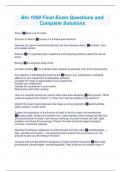Bio 1050 Final Exam Questions and
Complete Solutions
Atoms ✅Basic unit of matter
Structure of Atoms ✅consist of a nucleus and electrons.
Describe the type of chemical bonds that can form between atoms ✅covalent, ionic,
and metallic bonds.
Science ✅An organized way of gathering and analyzing evidence about the natural
world.
Biology ✅the scientific study of life
scientific thinking ✅The cognitive skills required to generate, test, and revise theories
Key aspects of well designed experiments ✅Ensure your experiment is unbiased.
Make sure your experiment is adequately powered.
Consider the range of applicability of your experiment.
Simplify your experiment.
Indicate the uncertainty in your results.
References and further reading.
How can scientific thinking be used to help make wise decisions ✅Ask yourself, "What
evidence supports this choice?" or "How can I test the validity of this decision?"
Identify the major macromolecules that make up living organisms ✅carbohydrates,
lipids, proteins, nucleic acids
Explain the importance of the function of each of the four major macromolecules
✅Nucleic acids: Stores and transfers info. Carbohydrates; Store energy, provide fuel,
and build structure in body, main source of energy, structure of plant cell wall. Lipid:
Insulator and stores fat and energy. Protein: Provide structural support,transport,
enzymes, movement, defense.
describe the different categories of carbohydrates and their uses ✅Carbohydrates —
fiber, starches and sugars — are essential food nutrients that your body turns into
glucose to give you the energy to function.
compare and contrast different categories of lipids and their structures ✅fatty acids,
glycerolipids, phospholipids, and sphingolipids. Fatty acids are the simplest type of
, lipids. They consist of long chains of carbon atoms with hydrogen atoms attached to
them. They are divided into two groups: saturated and unsaturated fatty acids.
Understand the importance of shape in the functioning of a protein ✅Collagen in our
cartilage and tendons, for instance, has a three-stranded, rope-like structure that makes
it strong. Enzymes—proteins that facilitate chemical reactions—typically have a pocket
that holds the molecule they act upon.
Compare and contrast DNA and RNA ✅DNA is a long polymer with deoxyriboses and
phosphate backbone. Having four different nitrogenous bases: adenine, guanine,
cytosine and thymine. RNA is a polymer with a ribose and phosphate backbone. Four
different nitrogenous bases: adenine, guanine, cytosine, and uracil.
Recall the definition of a cell and describe the two general types of cells ✅prokaryotic
cells and eukaryotic cells. Though the structures of prokaryotic and eukaryotic cells
differ (see prokaryote, eukaryote), their molecular compositions and activities are very
similar.
Describe the structure and functions of the cell membrane. ✅Structure: it separates
the cell from the environment
functions: allows nutrients to be absorbed & wastes to be removed
Describe how cells are connected and how they communicate with each other ✅Cells
communicate by sending and receiving signals. Signals may come from the
environment, or they may come from other cells. In order to trigger a response, these
signals must be transmitted across the cell membrane.
Describe nine important landmarks in eukaryotic cells ✅Eukaryotic cells contain a
plasma membrane, internal protein structures such as cilia, flagella, ribosomes, and
membrane-bound organelles such as mitochondria, nucleus, Golgi bodies, chloroplast,
lysosome, peroxisomes, and endoplasmic reticulum.
How energy flows from the sun and through all life on earth ✅Plants intake the suns
light and turn it into energy which ends up being ate by animals
how photosynthesis works ✅By raising the energy level of electrons in the chlorophyll
molecule, light energy can produce a steady supply of high energy electrons
How cellular respiration works ✅Oxygen and sugars are mixed in the mitochondria and
energy is released. The energy from each mitochondrion is used by the cells organelles
so they can work
Describe what DNA is and what it does ✅the molecule that carries genetic information
for the development and functioning of an organism. DNA is made of two linked strands




